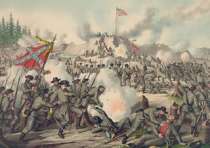
Sites include: Longstreet’s headquarters, Fort Dickerson, cemeteries, hospitals, site of mortal wounding of Ge. William P. Sanders, and Fort Sanders site. Brochures are available at the downtown Visitor Center.
The 18-day siege of Knoxville from November 17 to December 4, 1863, stemmed from two interrelated causes. First, General Braxton Bragg, commander of the Army of Tennessee, wanted to divert troops from the Federal army holding Chattanooga. Second, Bragg wanted to rid himself of Lieutenant General James Longstreet. Longstreet had been essential to the victory at Chickamauga but then had tried to have the incompetent, unpopular Bragg removed from command, hoping to be named in Bragg’s stead. When this attempt failed, Bragg detached Longstreet and his corps and ordered them to recapture Knoxville, which had fallen in early September to the Union force of Major General Ambrose Burnside.
On November 5, Longstreet headed north up the Tennessee Valley, while Burnside withdrew into the fortifications surrounding the city. Longstreet's troops sealed off all approaches to Knoxville, hoping to starve the garrison into submission. Longstreet and his chief engineer, Brigadier General Danville Leadbetter, determined that the old Confederate Fort Loudon offered the weakest link.
The November 29 attack led by Major General Lafayette McLaws failed utterly. Confederate soldiers lost the element of surprise when, in the predawn darkness, the advancing column became entangled in telegraph wire strung across the line of attack. The Confederates then discovered that what they thought was a shallow ditch was actually four to eight feet deep, creating a slaughter pen. The Federals laid down a murderous artillery and musket fire on the crowded Southern infantry. The few Confederates who made it inside the fort were quickly killed or captured.
It was all over in about twenty minutes. The Confederates suffered 813 casualties, a quarter of whom were prisoners who had surrendered rather than run the gauntlet of fire back to their own lines. Federal losses totaled five dead and eight wounded. When Longstreet learned of Bragg's rout from Chattanooga and Sherman's approach from the south, he lifted the siege on December 4 and withdrew into winter quarters in upper East Tennessee.
Tools
Key Facts
- Confederate Gen. James Longstreet attempted to capture Knoxville and the army of Union Gen. Ambrose E. Burnside in November, 1863.
- Union Gen. William P. Sanders was mortally wounded.
- The Confederate attack on Fort Sanders was unsuccessful.




